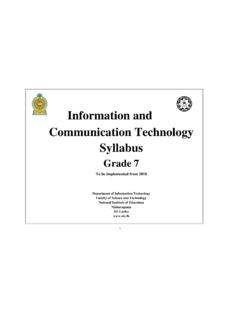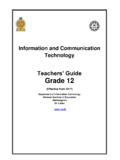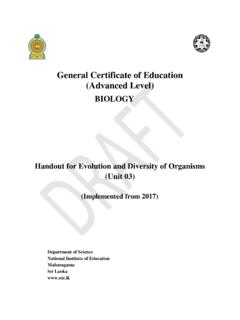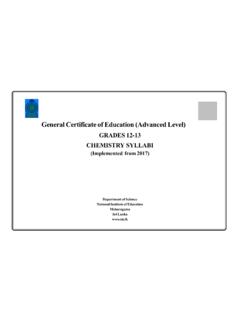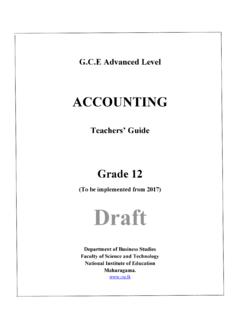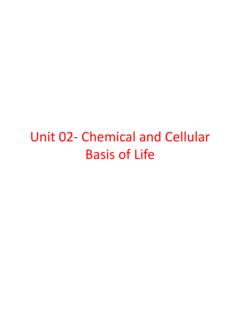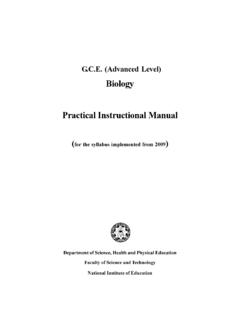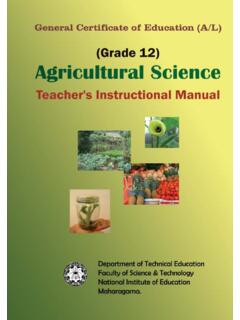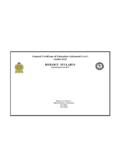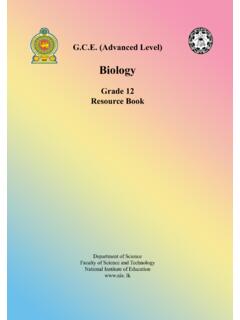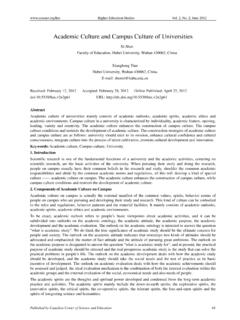Transcription of Information and Communication Technology - nie.lk
1 Information and Communication Technology Syllabus Grades 12 and 13. (Effective from 2017). Department of Information Technology National Institute of Education Maharagama Sri Lanka Information and Communication Technology Grade 12 and 13 - syllabus National Institute of Education first print 2017. ISBN: Department of Information Technology Faculty of Science and Technology National Institute of Education Maharagama Printed by: CONTENTS Page No Introduction .. ii Common National Goals .. iii Basic - v Objectives of the Subject .. vi Basic Competencies mappingwith Common National Goals .. vii Proposed number of periods for each units .. viii Syllabus .. 1 46. Learning Teaching process .. 47. School Policies and Programs .. 48. Assessment and Evaluation .. 49. i Introduction Information and Communication Technology has been identified worldwide as a tool that can be used to improve productivity, efficiency and effectiveness of organizational work and the daily activities of individuals.
2 Therefore, providing an adequate level of ICT. knowledge and skills, at different levels of education, is important for the students to progress and contribute towards national development. The current Sri Lankan Secondary Education System has been substantially exposed to ICT through various programs including CAL, ICT for GCE (O/L), GIT at grade 12 and ICT as a component in A/L Technology stream. Consequently, students have shown a growing interest in ICT education and some have, in fact, performed excellently at international competitions in ICT, proving their high level of competence. ICT as a main subject for GCE (A/L) was introduced in 2007. The syllabus was revisited in 2013. According to the syllabus revising policy the syllabus was revised in 2017. GCE (O/L) qualified students who are interested in developing their career path in ICT, have the opportunity of learning it at the GCE (A/L). ICT as a subject for A/L would set a national standard in ICT education at school level and provide the path to higher education at tertiary level.
3 Furthermore, students who fail to earn a placement in a university would be in possession of a substantial foundation to build up their academic and professional careers. The ICT syllabus at GCE (A/L) communicates core concepts of ICT covering both theoretical and practical usage of ICT. This will also strengthen student's awareness of the new trends and future directions of ICT. Also this subject will provide an added advantage to students by improving their soft skills, thereby enabling them to best fit into working environments. ii National Goals 1. Based on the concept of respecting human values and understanding the differences between the Sri Lankan multi-cultural society, building up the nation and confirming the identity of Sri Lanka by promoting national integrity, national unity, national coherence and peace 2. While responding to the challenges of the dynamic world, identifying and conserving the National heritage. 3. Creating an environment which comprises of the conventions of social justice and the democratic life to promote the characteristics of respecting the human rights, being aware of the responsibilities, concerning each other with affectionate relationships.
4 4. Promoting a sustainable life style based on the people's mental and physical well-being and the concept of human values 5. Promoting the positive feelings needed for balanced personality with the qualities of creative skills, initiative, critical thinking and being responsible 6. Through education, developing the human resources, needed for the progress of the well-being of an individual, the nation as well as the economic growth of Sri Lanka. 7. Preparing the people for the changes that occur in a rapidly changing world by adapting to it and controlling them;. developing abilities and potentialities of people to face the complex and unexpected occasions. 8. Sustaining the skills and attitudes based on justice, equality, mutual respect which is essential to achieve a respectable place in the international community. National Education Commission Report (2003). iii Basic Competencies The competencies promoted through the education mentioned below might help to achieve the above mentioned National Goals.
5 1. Competencies in Communication This first set of competencies is made up of four subsets - Literacy, Numeracy, Graphics and Information Communication skills: Literacy: Carefully listening, speaking clearly, and Reading for comprehension, writing clearly and accurately. Numeracy: Using numbers to count, calculate, code and to measure, matter, space and time Graphics: Making sense of line and form, expressing and recording essential data, instructions and ideas with line, form, colour, two and three-dimensional configurations, graphic symbols and icons ICT Competencies: Knowledge on computers, and the ability to use the Information Communication skills learning or work as well as in the private life 2. Competencies relating to the Personality Development Generic skills such as creativity, divergent thinking , initiative, decision making, problem-solving, critical and analytical thinking , team work, inter-personal relationships, discovering and exploring Values such as integrity, tolerance and respect for human dignity Cognition iv 3.
6 Competencies relating to the Environment This is the second set of competencies related to the Social, Biological and Physical Environments. Social Environment: Awareness, sensitivity and skills linked to being a member of society, social relationship, personal conduct, general and legal conventions, rights, responsibilities, duties and obligations. Biological Environment: Awareness, sensitivity and skills linked to the living world, man and the ecosystem, the trees, forests, seas, water, air and plant-life, animal and human life. Physical Environment: Awareness, sensitivity and skills relating to space, energy, fuels, matter, materials and their links with human living, food, clothing, shelter, health, comfort, respiration, sleep, relaxation, rest, wastes and excretion, media of Communication and transport. Included here are the skills in using tools to shape and for materials for living and learning 4. Competencies relating to preparation for the world of work Employment related skills to maximize their potential and to enhance their capacity to contribute to economic development; to discover their vocational interests and aptitudes; to choose a job that suits their abilities and to engage in a rewarding and sustainable livelihood.
7 5. Competencies relating to religion and ethics This fourth set of competencies laden with values and attitudes. It is essential for individuals to assimilate values, so that they may function in a manner consistent with the ethical, moral and religious modes of conduct, rituals, practices in everyday living, selecting the most appropriate. v 6. Competencies in play and use of leisure Competencies that link up with pleasure, joy, emotions and such human motivations. These find expression in play, sports, athletics and leisure pursuit of many types. These also link up with such values as cooperation, team work, healthy competition in life and work. Here are included such activities as are involved in aesthetics, arts, drama, literature, exploratory research and other creative modes in human living. 7. Competencies relating to Learning to learn'. These competencies flow directly from the nature of a rapidly changing, complex and interdependent and crowded world whatever one learns, that learning will need updating and review.
8 This requires that one should be aware of, sensitive and skilful in sustained attention, and be willing to persevere and attend to details that matter in a given situation. vi Objectives of the Subject This syllabus enables students to: Establish the foundation for ICT education leading to higher education Establish the foundation to build up their professional career Produce entry level ICT human resources required for the industry Enable to use ICT effectively in achieving Sustainable Development Goals (SDG). Provide students with ICT knowledge to improve the quality of life in general Provide awareness of the importance of computer networking for Communication Improve the skills required for the development of ICT based solutions for real world problems Provide awareness of the new trends and future directions of ICT. Enable to use ICT for innovation and researches Develop an appreciation of the role of ICT in a knowledge-based society vii Basic Competencies Mapping No Basic Competencies Units 1 Competencies in Communication 1, 2, 3, 4, 5, 6, 7, 8, 9, 10, 11, 12.
9 2 Competencies relating to the Personality Development 3, 8, 9, 12. 3 Competencies relating to the Environment Social Environment 7, 11. Biological Environment 12. Physical Environment 2, 3,7. 4 Competencies relating to preparation for the world of work 6, 8, 9, 10. 5 Competencies relating to religion and ethics 6. 6 Competencies in play and use of leisure 11. 7 Competencies relating to Learning to learn' 2, 4, 8, 6, 9, 10. viii Proposed number of periods for each units No Units No. of periods 1 Concept of ICT 28. 2 Introduction to Computer 22. 3 Data Representation 18. 4 Fundamental of Digital Circuits 26. 5 Computer Operating System 22. 6 Data Communication and Networking 50. 7 System Analysis and Design 68. 8 Database Management 50. 9 Programming 74. 10 Web Development 60. 11 Internet of Things 15. 11 ICT in Business 12. 12 New trends and Future Directions of ICT 12. 13 Project 30. ix Competency Competency Level Contents Learning outcomes Periods Competency 1: Investigates the Life cycle of data Defines data and Explores the basic building o Data creation outlines its life cycle basic concepts blocks of o Management Recognizes the of ICT together Information and o Removal of obsolete data need of a process to with its role and their Data vs.
10 Information define data and applicability in characteristics Definition of Information Information today's Characteristics of valuable Information : Recognizes the knowledge timeliness, accuracy, presented within strong inter based society the context, enhanced relationship between understandability and less uncertainty data, process and The need to handle large volumes and Information other complexitiesof data Describes data, - Introduction process and Information Lists various forms 6. of data and their characteristics Describes the characteristics of quality data Distinguishes data from Information Illustrates the value of Information Describes the characteristics of valuable Information Recognizes big data, their needs and analysis Investigates the Applicability of Information in day to Identifies the 6. 1. Competency Competency Level Contents Learning outcomes Periods need of Technology day life drawbacks of to create, o Decision making manual data disseminate and o Policy making processing methods manage data and o Predictions Describes the Information o Planning, scheduling and monitoring importance of Drawbacks of manual methods in Information in day to manipulating data and Information day life o Inconsistency and duplication in Lists the available data, room for errors, human errors technologies related and delay in processing to Information o Lack of sharing Information and dissemination reduced customer services Investigates the Infeasibility of applying manual development of methods where they can beharmful to computer networks, humans the Internet and Emergence of ICT era WWW.
